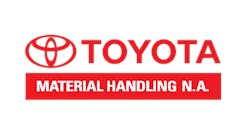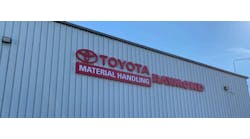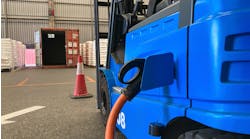STORE: AS/RS Fires-Up Productivity in Deep-Freeze Warehouses
Increasingly, frozen food producers and distributors need to trace and identify where each product lot originated, where pallets came from, where they were stored, what the temperature was in storage, and other critical data to keep track of their perishable inventory and ensure its product integrity. Automation of deep-freeze warehousing can help fulfill these needs. An example can be found in high-bay, high-density storage utilizing automated storage and retrieval systems (AS/RS).
"Automation, such as AS/RS, in high-bay deep freeze warehouses can reduce the cost of operation and give an economic advantage in the marketplace," says Ned Gregory, president, Suncup Juice (www.suncupjuice.com), division of Gregory Packaging, Inc., a manufacturer and distributor of frozen juice products. "By bringing the frozen product to the worker, it significantly reduces travel time by workers, wrong picks and product and facility damage, which are prevalent in contemporary deep-freeze warehouses using forklifts."
Defrosting Efficiency
AS/RS cranes are computer-controlled material handling machines for automatically depositing, storing and retrieving pallet loads from defined storage locations. These stacker cranes are central to the AS/RS, permitting full-pallet load and layered-pallet inventory to be moved quickly, safely and precisely within a high-bay warehouse environment.
"Modern cranes operate within a set of top and bottom rails, which stabilize the crane, allowing greater load capacities, as well as higher rack heights," says Daryl Hull, president North America, LTW Intralogistics (www.ltwusa.com), a manufacturer of stacker cranes for high-bay warehouses, including deep-freeze facilities. "It is this capability of the stacker crane that makes possible high-bay, deep-freeze storage. Benefits include maximized building volume and increased cost efficiency."
Within deep-freeze high-bay warehouses, it is possible to have as many as 25 vertical pallet positions on racks 145 feet high. For the deep-freeze warehouse environment this is an important efficiency factor in footprint consolidation. The footprint reduction becomes an increasingly critical factor in energy savings since much of the cold loss in a sub-zero warehouse occurs through the roof.
Recent AS/RS developments provide significant benefits for deep-freeze warehousing:
-
Load Handling – The latest designs of stacker cranes for use in high bay deep-freeze warehouses can carry multiple pallet types with payloads over 3,000 pounds total, traveling at vertical speeds of 325 feet-per-minute (FPM) and achieving horizontal travel speeds of 787 FPM. High-speed PLCs with integrated controls architecture monitor the movements of the cranes in coordination with the warehouse management system (WMS) via Ethernet. Digital track positioning, infrared and laser guidance direct the movement of the cranes within the high-bay.
From the floor level to up to 145 feet tall, the AS/RS stacker cranes can provide single-deep, double-deep, triple-deep and multi-deep stacking, with the flexibility to handle one pallet load at a time or multi-loads. The latest stacker cranes can go three pallets deep with a telescope fork, and then with a satellite remote unit can run a pallet 40 feet into the racking—as much as 10 pallets deep, and then return back to the stacker crane.
Such systems permit rapid and efficient pallet handling and product rotation, essential to the needs of contemporary deep-freeze warehouses.
-
Aisle-Changing Capability – With aisle-changing stacker cranes, the number of cranes can be matched to the warehouse throughput instead of to the number of aisles.
"These cranes can be easily and quickly deployed to any aisles where pallet picking is needed, and withdrawn from aisles when picking is slow," explains Hull. "When a crane gets to the end of an aisle, the operator simply throws a switch in the cab which moves the crane to a track running perpendicular to the aisle. The crane then smoothly rotates around the end of the aisle on a 10-foot radius curved track, without leaving the track. It makes for an easy and fast transition between aisles."
-
Integrated Controls Architecture – The most advanced models of AS/RS use integrated controls architecture for material flow control. These systems integrate the AS/RS with other automated equipment in the deep-freeze warehouse creating one system. The AS/RS' wireless Ethernet and drives are located in a heated cabinet on the unit, while the programmable logic controllers (PLCs) and remote touch panel human machine interface (HMI) can be stationed outside the deep-freeze in a chilled or ambient temperature room. The controls system enables optimized speed and precision with AS/RS positioning.
-
Energy Efficiency – Modern systems reduce energy consumption by operating servo-motors at variable speeds depending on the demand load in the warehouse. Cranes can generate electricity from lowering their lift carriages, using their motors as a generator. Electricity is then put back into the main power supply. The system also contributes energy from friction when braking on downward vertical motion. The energy regeneration can account for up to 40 percent of the AS/RS' total power usage.
-
Load Tracking – Deep-freeze, high-bay warehouses can track frozen products. The warehouses' WMS along with PLCs in the AS/RSs, are capable of monitoring batch numbers, production dates and weight as the unit loads and cases are moved through and stored in the facility.
Products arriving in the warehouse are tracked with pallet labels. Pallets are received and scanned, associating with prior electronically-received purchase orders in the WMS. They are then inducted into the automated high-bay warehouse. The WMS knows what the product are, and how many cases are on each pallet.
Temperature data loggers and/or radio frequency identification (RFID) tags can help monitor the temperature history of the incoming trucks, warehouse and of the product being shipped outbound.
"In a deep-freeze environment, workers can easily make tracking mistakes in the severe cold," continues Gregory. "It is a huge benefit to have this function automated, particularly as the demands for product tracking in the entire supply chain are continually getting tighter."
This level of WMS supply chain analytics allows sub-zero warehouses to maintain precise control on their products through every stage of their handling—from receiving, to storage, through picking and shipping.
-
Automated Picking Windows – This picking solution, utilizing AS/RS stacker cranes, automatically removes a pallet from the high-bay deep-freeze allowing rack replenishment or picking of cases from pallet flow in an area that is just below or above freezing. To minimize loss of refrigeration, pick windows are just large enough to accommodate the pallet load, and open and close only long enough to complete the delivery or pallet pickup cycle.
With a partial pallet pick, once the picking is complete, the stacker crane automatically returns the pallet back into the deep-freeze for storage.
Sliding picking windows can be equipped with tunnels that separate the picking gates from the stacker crane aisles to provide a safer boundary of operation for workers. This system enables dynamic order picking of frozen goods utilizing highly automated AS/RS integrated into a goods-to-person pick solution.
By incorporating the latest improvements in high-bay stacker crane systems, a frozen foods processor or distribution center can better adapt to changing throughput dynamics, while operating at a more cost-efficient level.
Robyn Schmitt writes on logistics automation.



